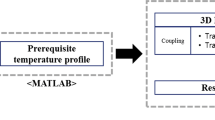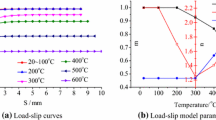Abstract
The focus of this effort is to develop models and numerical methods for coupled simulations of composite material response in fire environments. This research has comprised of two main activities. The first is the development of a thermo-mechanical damage model for composite materials subject to high temperature environments. The damaged composite is expressed as two regions of non-charred and charred materials. Homogenization methods are used to formulate the damaged material in terms of volume fractions of the composite fiber, resin, char and gas. Results are presented for a clamped beam case with comparison to experimental data for a glass-phenolic composite. Overall good agreement is observed between model predictions and measurements of temperature and pressure. The clamped beam is observed to undergo an interesting bifurcation for which the beam bows away from the applied heating load due to thermal expansion, but then later in time, bows towards the applied heat load after sufficient char is formed. The second research activity is on the development of fluid-structure coupling algorithms for simulating the coupled response of 2D composite structures and the local flow environment. Results show that the spatial distribution of material decomposition is sensitive to the local flow environment from the fire that, in turn, is defined by the structure geometry. Near the material surface enhanced heat transfer to the material surface is observed from the near-wall flame that is established by the resin off-gases. These observations highlight the importance in considering the coupled response of both the material response and the flow field for assessing the performance of composite structures for fire environments.

















Similar content being viewed by others
References
Mouritz A, Mathys Z (1999) Post-fire mechanical properties of marine polymer composites. Composite Structures 47:643–653
Mouritz A, Mathys Z (2001) Post-fire mechanical properties of glass-reinforced polyester composites. Composites Science and Technology 61:475–490
Mouritz A, Gellert E, Burchill P, Challis K (2001) Review of advanced composite structures for naval ships and submarines. Composite Structures 53:21–41
Mouritz A, Gardiner C (2002) Compression properties of fire-damaged polymer sandwich composites. Composites 33:609–620
DiBlasi C (2000) The state of the art of transport models for charring solid degradiation. Polymer International 49:1133–1146
Henderson JB, Wiebelt JA, Tant MR (1985) A model for the thermal response of polymer composite materials with experimental verification. Journal of Composite Materials 19:579–595
Henderson JB, Wiecek TE (1987) A mathematical model to predict the thermal response of decomposing expanding polymer composites. Journal of Composite Materials 21:373–393
Florio JJ, Henderson JB, Frederick LT, Hariharan R (1991) A study of effects of the assummption of local-thermal equilibrium on the overall thermally-induced response of a decomposing glass-filled polymer composite. J of Heat and Mass Transfer 34:135–146
Dimitrienko YI (1997) Thermomechanical behavior of composite materials and structures under high temperatures: 1. materials. Composites Part A 28:453–461
Dimitrienko YI (1997) Thermomechanical behavior of composite materials and structures under high temperatures: 2. structures. Composites Part A 28:463–471
Dimitrienko YI (1997) Internal heat-mass transfer and stresses in thin-walled structures of ablating materials. Int J Heat Mass Transfer 40(7):1701–1711
Dimitrinenko YI (1998) Mechanics of porous media with phase transformations and periodical structures 1. method of asymptotic averaging. Eurpean Journal of Mechanics -A/Solids 17(2):305–319
Dimitrinenko YI (1998) Mechanics of porous media with phase transformations and periodical structures 2. solutions of local and global problems. Eurpean Journal of Mechanics -A/Solids 17(2):321–337
Dimitrienko YI (2000) Thermomechanical behavior of composites under local intense heating by irradiation. Composites: Part A 31:591–598
Kuo KK (1986) Principles of Combustion. Wiley-Interscience
Ohlemiller TJ, Cleary TG (1999) Upward flame spread on composite materials. Fire Safety Journal 32:159–172
Luo C, DesJardin PE (2007) Thermo-mechanical damage modeling of a glass-phenolic composite materials. Compos Sci Technol 67:1475–1488
Matweb material property data. website, 2006. http://www.matweb.com
Irons B (1980) Techniques in Finite Elements. John Wiley & Sons, New York, NY
Shames IH (1989) Introduction to Solid Mechanics. Prentice-Hall, Inc., Englewood Cliffs, NJ
Belytschko T, Liu W, Moran B (2003) Nonlinear Finite Elements for Continua and Structures. Wiley, New York, NY
Hirt CW, Nichols BD (1981) Volume of fluid (vof) method for the dynamics of free boundaries. J of Comput Phys 29:201–225
Rudman M (1997) Volume-tracking methods for interfacial flow calculations. Int J for Num Methods in Fluids 24:671–691
Kleefsman KMT, Fekken G, Veldman VEP, Iwanowski B, Buchner B (2005) A volume-of-fluid based simulation method for wave impact problem. J of Comput Phys 206:363–393
LeVeque RJ, Li Z (1994) The immersed interface method for elliptic equations with discontinuous coefficients and singular sources. SIAM J Numer Anal 31(3):1019–1044
Udaykumar H, Mittal R, Shyy W (1999) Computation of solid-liquid phase fronts in the sharp interface limit on fixed grids. J of Comput Phys 153:535–574
Calhoun D (2002) A cartesian grid method for solving the two-dimensional streamfunction-vorticity equations in irregular regions. J of Comput Phys 176:231–275
Russel D, Wang ZJ (1989) A cartesian grid method for modeling multiple moving objects in 2D incompressible viscous flow. J Comput Phys 191:177–205
Baralas E (2004) Modeling complex boundaries using an external force field on fixed cartesian grid in large-eddy simulation. Comp & Fluid 33(3):375–404
Udaykumar H, Mittal R, Rampunggoon PAK (2001) A sharp interface cartesian grid method for simulating flows with complex moving boundaries. J of Comput Phys 174:345–380
Li ZML (2001) The immersed interface method for the navier stokes equations with singular forces. J of Comput Phys 171:822–842
Tseng Y, Ferziger JH (2003) A ghost-cell immersed boundary method for flow in complex geometry. J of Comput Phys 192:593–623
Marella S, Krishnan S, Liu H, Udaykumar HS (2005) Sharp interface cartesian grid method i: An easily implemented technique for 3d moving boundary computations. J of Comput Phys 210:1–31
White MF (1991) Viscous Fluid Flow, 2nd edition. McGraw-Hill, Inc, New York, NY
Westbrook C, Dryer F (1981) Simplified reaction mechanisms for the oxidation of hydrocarbon fuels in flames. Combust Sci and Tech 27: 31–43
Hoffmann K (1989) Computational Fluid Dynamics for Engineers. Engineering Education System, Autin, Texas 78713, USA
Leonard BP (1979) A stable and accurate convective modeling procedure based on quadratic upstream interpolation. Comput Methods Appl Mech Eng 19:59–98
Xie W, DesJardin PE (2008) A level set embedded interface method for conjugate heat transfer simulation of low speed 2D flows. Comput Fluids 37:1262–1275
Xie W, DesJardin PE (2009) An embedded upward flame spread modeling based on 2D direct numerical simulation. Combust Flame 156:522–530
McGrattan K, Baum H, Rehm RG, Hamins A, Forney G (2000) Fire dynamics simulator—technical reference manual. Technical report NISTIR 6467, National Institute of Standards and Technology, Gaithersburg, MD
DesJardin PE, O’Hern TJ, Tieszen SR (2004) Large eddy simulation and experimental measurements of the near-field of a large turbulent helium plume. Phys of Fluids 16:1866–1883
DesJardin PE (2005) Modeling of conditional dissipation rate for flamelet models with application to large eddy simulation of fire plumes. Combust Sci Technol 177:1881–1914
Drysdale D (1998) An Introduction to Fire Dynamics, 2nd edition. John Wiley and Sons, New York, NY
Sibulkin M, Kim J (1977) Combust Sci and Tech 17:39
Quintiere J, Harkleroad M, Hasemi Y (1986) Wall flames and implications for upward flame spread. Combust Sci and Tech 48:191–222
Acknowledgments
The authors gratefully acknowledge the financial support from Office of Naval Research (Grant Nos. N00014-03-1-0369 and N00014-06-1-0623) for supporting their research. Computer resources for the results presented by the authors are provided by the Center for Computational Research (CCR) at the University at Buffalo.
Author information
Authors and Affiliations
Corresponding author
Rights and permissions
About this article
Cite this article
Luo, C., Xie, W. & DesJardin, P.E. Fluid-Structure Simulations of Composite Material Response for Fire Environments. Fire Technol 47, 887–912 (2011). https://doi.org/10.1007/s10694-009-0126-4
Published:
Issue Date:
DOI: https://doi.org/10.1007/s10694-009-0126-4




